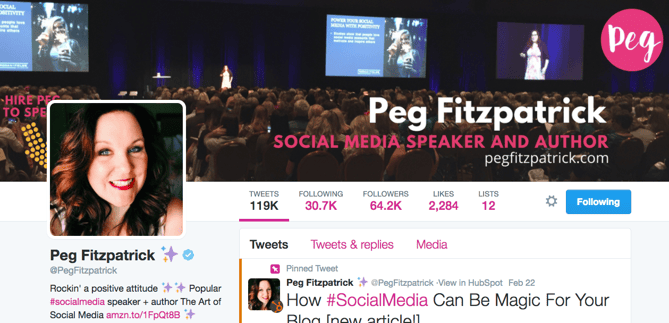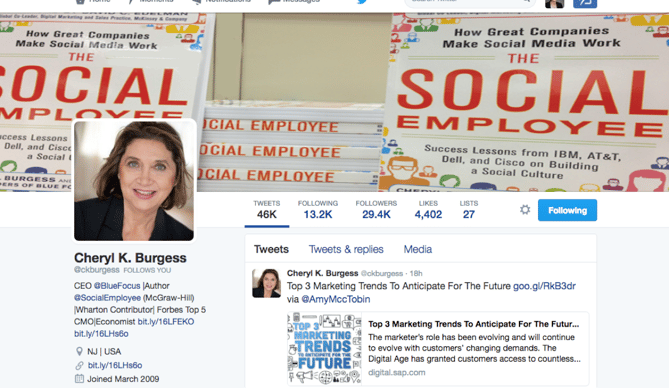How to Build a Memorable Personal Brand on Twitter. How to Build a Memorable Personal Brand on Twitter Step #1: Follow the leaders. While most people will find you through your content, they’ll then check out your Twitter profile. “I scan the headlines and if I read the article, I share it.” While it’s tempting to rely solely on curated content, if you’re serious about building your personal brand, try to post some original content. Actionable Takeaways: Don’t share content without identifying the source or the author, says Schaffer. “Put aside some time to reach out and engage with the tweets of your followers as well as influencers you would like to build a relationship with,” says Melonie Dodaro, a social selling speaker and trainer and author. Over time, you will become an authority yourself.” “Be yourself. Now I focus on those people who really seem interested in connecting.” Don’t automate direct messages. Actionable Takeaway: Take time to find the right tool for measuring and analyzing. You’ll have sent hundreds of tweets, created dozens of blog posts, connected with lots of great people and learned more than you would have ever imagined.” Actionable Takeaway: Find your focus by following one course until successful and stick to it, says Smith.

Imagine that you’re within 140 characters of connecting with a customer, prospect, or influencer. How can you afford not to reach out?
We’re talking Twitter, of course: the 300-million strong whirlpool of information that has emerged as a personal branding, relationship-building nirvana.
Twitter pros have found ways to use the platform to score business and media deals — they’ve even built relationships through developing successful Twitter personal brands. Yet, too many people have joined the community simply because they know they should be there, not because they’re strategic or focused.
When it comes to those that have managed to scale their following and build a reputable brand on Twitter, there’s a lot we can learn. To do this, I decided to go straight to the source, interviewing some well-known names with as many as hundreds of thousands of followers.
Thanks to their insights and generosity, I put together a eight-step road map for developing your personal brand on Twitter. Check it out below.
How to Build a Memorable Personal Brand on Twitter
Step #1: Follow the leaders.
Cheryl Burgess, author and CEO of Blue Focus Marketing, said she started off as a listener on Twitter, following people she admired like Kent Huffman, Tom Peters, and David Edelman, among others.
You see, the beauty of Twitter is that you don’t have to go far to discover a successful marketing playbook. The platform gives you free reign to observe how the pros do it.
Similarly, Neal Schaffer, CEO of Maximize Your Social and cofounder of The Social Tools Summit, says to follow people who are sharing a lot of content and who are omnipresent on Twitter. For Schaffer, that’s folks like Jeff Bullas, Mark Schaefer, Pam Moore, Lilach Bullock, Marsha Collier, and Glen Gilmore.
Over time, in addition to observing Twitter luminaries at work, start to engage them. Influencers, like anyone, appreciate praise. But don’t expect an immediate home run. If the influencer eventually follows you — or even better mentions you — you’ve scored a coup.
If you do directly reach out, see what you can offer in return – a mention in a blog post or article for instance. Burgess said she developed a relationship with Tom Peters by following him on Twitter and also recognizing him as part of a Twitter awards program she was running.
If you’re wondering what impact influencers can have, consider this: Nearly 40% of Twitter users say they made a purchase as a direct result of a tweet from an influencer.
Actionable Takeaways:
- Create Twitter lists of your mentors whom you can then easily monitor. Think of it as having a front row seat to your favorite performers. “Grouping my audience into categories, I see what’s happening across the world quickly and seek opportunities to help and respond,” says Mark Schaefer.
- Visualize your Twitter ecosystem using a tool like Mentionmapp. “Mentionmapp helps me decide whom to follow and the conversations I need to be part of,” says Burgess.
Step #2: Define your brand.
Clarify the type of person you want to be on Twitter. Think of this as an opportunity to showcase your capabilities, passions, and interests.
Peg Fitzpatrick, social media speaker, trainer, and author, refers to this exercise as “defining the seeds of your brand.” Fitzpatrick advises selecting two or three main topics for your brand content — for her personal brand, she zeroes in on media, her role as author (and speaker), and marketing.

Mari Smith, social media speaker, trainer, consultant, and author, has done this beautifully, explaining that she shares “quality, cherry-picked content pertaining to social media, business development, and time and life hacks with a sprinkling of spiritual uplift and a daily dose of motivational quotes.”
Actionable Takeaway:
- Focus on three seeds, or go super-niche with one main focus. Do this and “you’ll build a solid Twitter following that will love your content,” says Fitzpatrick.
Step #3: Sharpen your profile.
Don’t leave your Twitter profile to chance or whim. It’s your face to the world on Twitter. While most people will find you through your content, they’ll then check out your Twitter profile.
Ensure that it defines your brand. Dump the default Twitter egg and use an image that highlights your brand, advises Burgess.
Burgess’ own profile leaves no doubts about her accomplishments and her focus:

Actionable Takeaway:
- Avoid the pet photos. “Unless you’re a veterinarian or your social media goals aren’t especially business related,” says Burgess, “it’s probably better to go with something else.”
COMMENTS